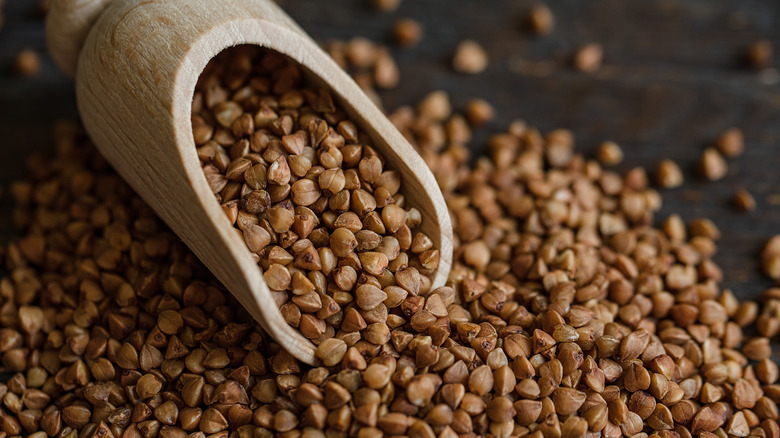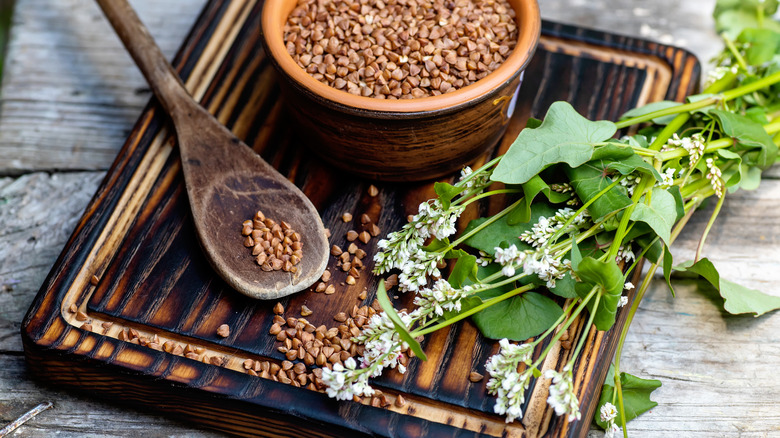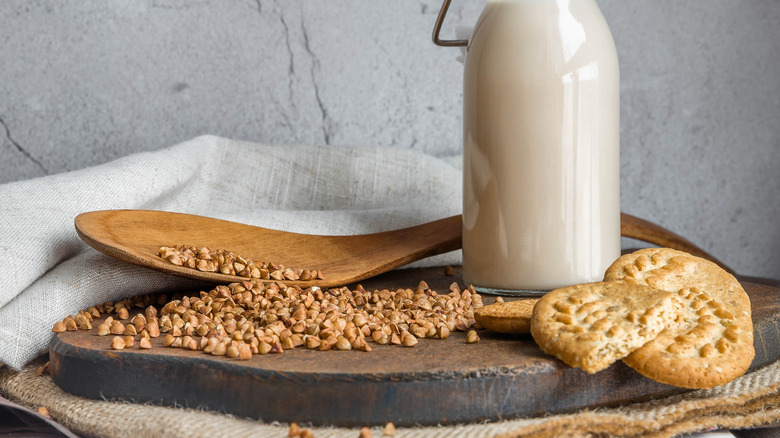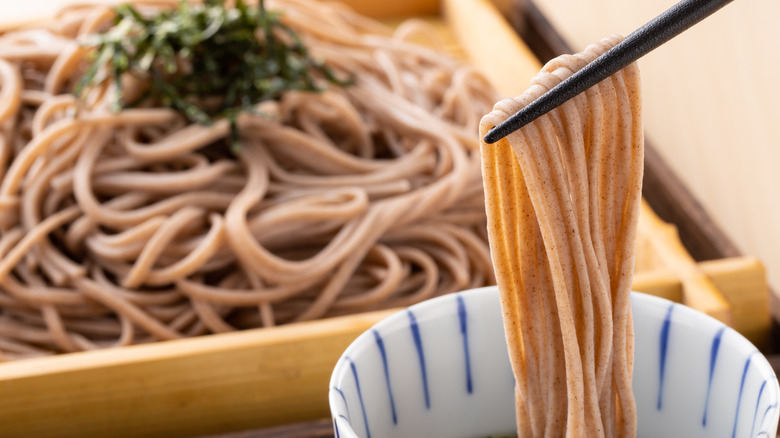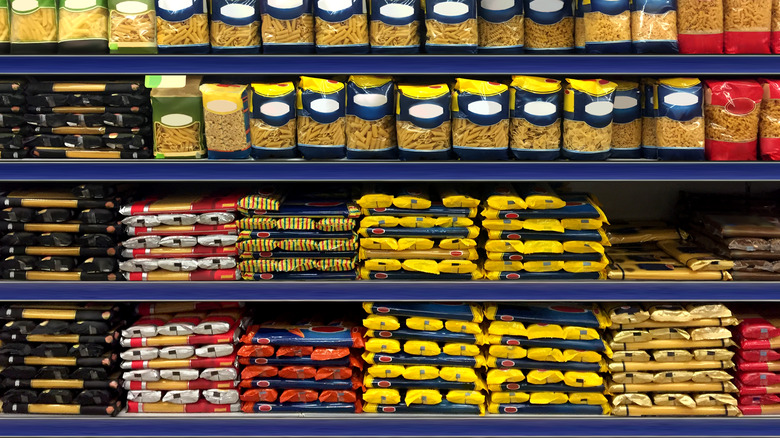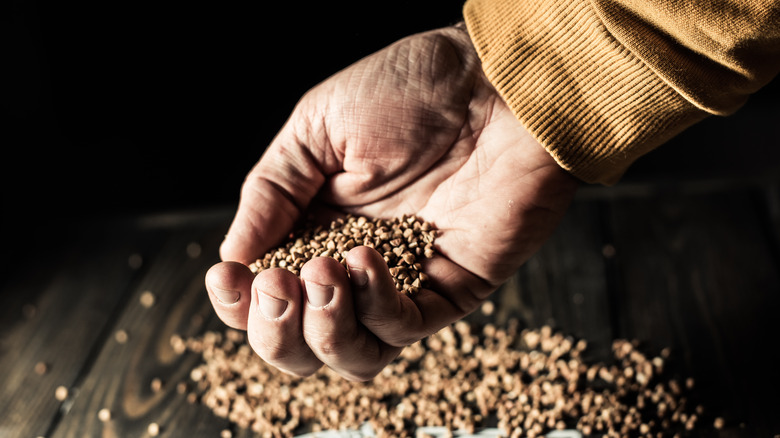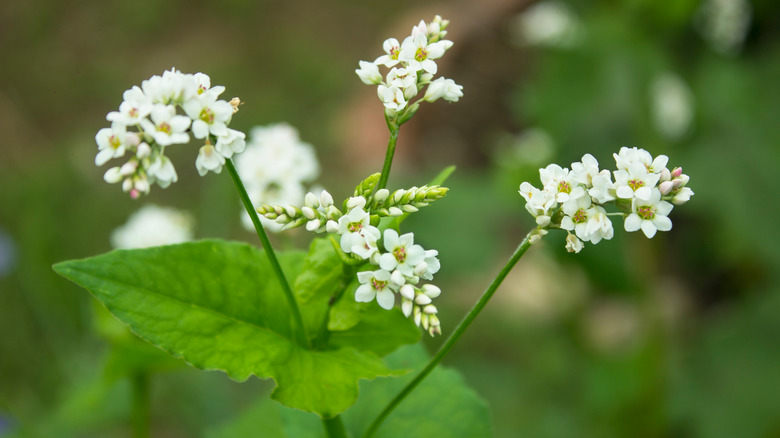What Is Buckwheat And Is It Nutritious?
You know how the peanut is not actually a pea or a nut, but rather a legume? That's rather the deal with buckwheat also: It's not wheat, and in fact it's not really a grain at all. According to The Healthy, buckwheat is actually a seed — or at least the part of the plant you eat is a seed, anyway. Overall, buckwheat is what is called a "pseudo-cereal" or "pseudo-grain," which is to say a foodstuff wherein the seed is eaten more like a cereal grain despite not growing on a grass. You can compare buckwheat to a few other pseudo-cereals like quinoa or millet, both of which are usually treated more like a cereal grain (wheat, rice, or barley being the most common examples) despite not actually growing in the same manner.
Admittedly, the pseudo-cereal category is a bit confusing, the definitions used being a bit ambiguous. But there is nothing ambiguous about the health benefits of buckwheat. Buckwheat is an immensely nutritious food and is even referred to as a "superfood" by many health and nutrition experts, according to Medical News Today. We'll discuss some of the specific health benefits of buckwheat later, but for now, the broad strokes can be summed up like this: Buckwheat is good for heart health, digestive health, regulated blood sugar, and is rich in vitamins and minerals. And what's more, according to Health Line: "buckwheat does not have any known adverse effects when eaten in moderation."
The health benefits of buckwheat
As noted, buckwheat is so nutritious as to often be called a superfood. But let's take a closer look at some of the specific healthy attributes of this unique pseudo-cereal. According to Health Line: "The nutritional value of buckwheat is considerably higher than that of many other grains." One 3.5-ounce serving of raw buckwheat is relatively low in calories, with just over 340 calories per that serving size. It is quite high in protein, with just over 13 grams of this vital nutrient in that serving amount. You can also enjoy 10 grams of fiber, just 3.4 grams of fat, and zero sugars per 3.5-ounce portion of raw buckwheat.
As for minerals, buckwheat delivers iron, copper, manganese, phosphorous, and more, and "compared to other grains, the minerals in cooked buckwheat groats are particularly well absorbed" (via Health Line). Buckwheat is good for blood sugar regulation, especially for those with diabetes, and is good for the heart thanks in large part to its ability to help lower unwanted LDL cholesterol and increase HDL, the so-called "good cholesterol."
Because buckwheat is very high in fiber, it is good for digestive and colon health and may even reduce the likelihood of the development of skin cancer.
What does buckwheat taste like?
On its own, buckwheat does not boast a bounty of flavor. Were you to simply boil and then eat a spoonful of buckwheat, you would almost surely be underwhelmed. The taste is something like wheat, albeit with a bit more bitterness and a slightly nutty profile. Roasting buckwheat groats opens up a bit more flavor, with notes akin to the hops you know from certain beers emerging, according to Thrive Cuisine. Where buckwheat shines is in soaking up other flavors: Like quinoa, farro, couscous, and myriad other grains (and pseudo-grains and cereals and such), buckwheat can blend beautifully into dishes of all different types.
You can eat buckwheat raw without internal health implications, but the tough groats will do a number on your teeth. To eat it "raw" and enjoy the nutrients of this superfood in minimally altered form, it's best to treat it like you would with raw, whole oats and soak the buckwheat groats in cold water for a number of hours. Use any overnight oat recipe as your guide (via Kay Nutrition).
The many forms of buckwheat and how to use them
In its whole groat form, as mentioned, buckwheat can be used as stand-in for oats by being soaked or boiled. It can be consumed like a rice or barley, boiled until tender and eaten as a principal starch, or else added to a salad or wrap for increased heartiness and some satisfying texture. You can also roast or pan fry (dry fry) buckwheat groats to give some added crunch to a salad or to sprinkle over a roast (via BBC Good Food).
Buckwheat flour is a great substitute for wheat flour (or other flours, like almond flour) in many recipes and is also often used in tandem with wheat flour or another type of flour to make breads, pastries, or other foods that are rich in taste and nutrients. Pure buckwheat flour usually has about 100 calories per quarter cup serving and is free of fats and sodium. It can be used interchangeably with wheat flours in many recipes.
Buckwheat is also very commonly used to make noodles, and especially the soba noodles common in Japanese cuisine. In this form, buckwheat noodles are great served hot in soups or stir-fry dishes or served cold as well. Buckwheat noodles cook quickly and retain the nutrition for which the pseudo-cereal is celebrated.
Where to buy buckwheat
You can buy buckwheat at just about any sizable, reputable grocery store you're likely to poke around in, and what's more, you can order the stuff online in myriad forms. For example, on Amazon, you can find a 2-pound bag of buckwheat online for less than $15, and this in the whole groat, unprocessed form. You can also order soba buckwheat noodles, Japanese Hime noodles made of buckwheat, ramen buckwheat, and more. And of course, buckwheat flour is also easy to find online as well as at most grocery stores.
There are other buckwheat adjacent products to consider, such as buckwheat honey, which is honey made by bees feeding exclusively on buckwheat flour nectar. Per Health Line, the resultant honey is a deeper brown than standard honey and is robust and without cloying sweetness. You can also get buckwheat pasta, buckwheat pancake and waffle mix, buckwheat crackers, and on the list goes.
Is buckwheat gluten-free?
Buckwheat is completely gluten-free, according to Health Line, so people diagnosed with celiac disease or those simply trying to avoid gluten for any other reason can indulge in this superfood pseudo-cereal to the fullest. The fact that buckwheat is gluten-free is one of the main reasons it is such a popular substitute for wheat in so many foods and recipes.
That said, note that in some rare cases people will present an allergy to buckwheat itself. If you are allergic to latex or to rice, be particularly wary when trying buckwheat or food products containing it, and watch out for symptoms like a rash, digestive ailment, swelling, or even anaphylactic shock in some extreme (and fortunately extremely rare) cases (per Livestrong). Allergies to buckwheat are often only even discovered when the food is eaten in large quantities and with frequency, and the symptoms are usually mild and rarely dangerous at any rate.
How and where does buckwheat grow?
Scientifically known as Fagopyrum esculentum (via J-Stage), buckwheat gets its name due to the shape of its groats resembling the seed of the beech tree, which in Dutch is called the "boec" tree, and due to the fact that it is cooked and consumed much like wheat.
According to the Agricultural Marketing Resource Center (AgMRC), cultivation of buckwheat likely originated in ancient China some 6,000 years ago. Today, China and Russia are the world's largest producers of the pseudo-cereal, though it grows in many other places as well. Buckwheat is grown commercially in more than a dozen states in America, and it is considered a commercially successful crop.
"Buckwheat is a relatively low input crop that has relatively high yields even in marginal soil," (via AgMRC). It grows to maturity in about a month's time and is often ready for harvest in as little as two months. It is usually good at outcompeting weeds and other plants, and it's known for imparting good nutrients to the soil.
Buckwheat must be planted each and every year, with groats — which are seeds, after all — from one year's crop able to be used to plant the next growing season's bounty of buckwheat.
